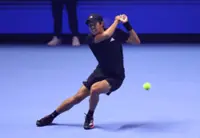A staff member spreads calcium chloride crystals on the surface of the Court Philippe-Chatrier on May 21, ahead of the 2025 French Open at the Roland Garros Complex in Paris. — Photos: AFP
The almost cathedral-like silence of Court Philippe Chatrier is broken only by the thrumming of large squeegees scraping the clay: it’s 6.30am and the groundstaff team quietly enters the arena to tend to the soon-to-be centuries-old ochre of Roland Garros in Paris, France.
With the aid of shovels, brooms and wheelbarrows – and a dose of elbow grease – the 180 or so specialised staff, most of whom are temporary workers, toil from dawn till dusk to whip the 18 courts into pristine condition for the year’s second Grand Slam.





